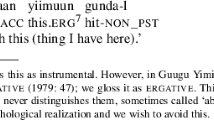Abstract
This paper presents a formalization of the common structure underlying different proposals concerning the geometry of phonological features. Using the concepts and tools of elementary set theory, lattice theory, and the theory of independent Boolean algebras, ametatheory of autosegmental feature structure is developed. This metatheory enables us to compare contemporary autosegmental phonology to the now abandoned “standard” phonology and to the historically important Pānini-type phonology as well, and to investigate the restrictions on the use of features in phonological theory.
Similar content being viewed by others
References
D. Archangeli, Yokuts harmony: evidence for coplanar representation in nonlinear phonology, Linguistic Inquiry 16(1985)335–372.
D. Archangeli and D. Pulleyblank,The Content and Structure of Phonological Representations (MIT Press, Cambridge, MA, 1993).
L.R. Bahl, P.V. de Souza, P.S. Gopalakrishnan, D. Nahamoo and M.A. Picheny, Decision trees for phonological rules in continuous speech, in:ICASSP-91, Toronto (1991) pp. 185–188.
G. Cardona, On Pānini's morphophonemic principles. Language 41(1965)225–237.
C. Cherry, Roman Jakobson's distinctive features as the normal coordinates of a language, in:For Roman Jakobson, ed. M. Halle (Mouton, The Hague, 1956).
C. Cherry,On Human Communication (MIT Press, Cambridge, MA, 1957).
C. Cherry, M. Halle and R. Jakobson, Toward a logical description of languages in their phonemic aspect, Language 29(1953)34–46.
N. Chomsky,Aspects of the Theory of Syntax (MIT Press, Cambridge, MA, 1965).
N. Chomsky and M. Halle,The Sound Pattern of English (Harper & Row, New York, 1968).
G.N. Clements, The geometry of phonological features, Phonology Yearbook 2(1985)225–252.
G.N. Clements, Phonological feature representation and the description of intrusive stops, in:CLS Parasession on Autosegmental and Metrical Phonology, Vol. 23, ed. A. Bosch, B. Need and E. Schiller (1987) pp. 29–50.
A. Ehrenfeucht, private communication.
V.A. Fromkin and R. Rodrnan,An Introduction to Language (Holt, Rinehart and Winston, New York, 1974).
J.A. Goldsmith,Autosegmental and Metrical Phonology (Basil Blackwell, Cambridge, MA, 1990).
M. Grammont, La dissimilation consonatique dans les languages indo-européennes et dans les langauges romanes, Dijon (1895).
M. Halle, On the bases of phonology, in:The Structure of Language, ed. J.A. Fodor and J. Katz (Prentice-Hall, Englewood Cliffs, NJ, 1964) pp. 324–333.
M. Halle and P. Ladefoged, Some major features of the International Phonetic Alphabet, Language 64(1988)577–582.
B. Hayes, Inalterability in CV phonology, Language 62(1986)321–351.
H. van der Hulst, The geometry of vocalic features, Leiden Papers in Linguistics and Phonetics (1988).
J. Itô, A. Mester, E. Selkirk and H. van der Hulst, Properties of feature organization, Reading materials for NSF-sponsored Workshop BNS-9021357, LSA Linguistic Institute, UC Santa Cruz (1991).
O. Jespersen,Lehrbuch der Phonetik (Teubner, Leipzig, 1904).
W. Leben, Suprasegmental phonology, Ph.D. Thesis, MIT, Cambridge, MA (1973).
J.J. McCarthy, Feature geometry and dependency: a review, Phonetica 45(1988)84–108.
E.C. Sagey, The representation of features and relations in non-linear phonology, Ph.D. Thesis, MIT (1986).
W. Sandler, Sequentiality and simultaneity in American Sign Language phonology, Ph.D. Thesis, The University of Texas at Austin (1987).
B. Schein and D. Steriade, On geminates, Linguistic Inquiry 17(1986)691–744.
J.F. Staal, A method of linguistic description: the order of consonants according to Pānini, Language 38(1962)1–10.
K.N. Stevens and S.E. Blumstein, The search for invariant acoustic correlates of phonetic features, in:Perspectives on the Study of Speech, ed. P. Eimas and J. Miller (Lawrence Erlebaum Associates, Hillsdale, NJ, 1981).
Author information
Authors and Affiliations
Additional information
This paper benefited a great deal from the comments of the participants at MOL2, Paul Kiparsky, and an anonymous reviewer — all remaining errors are my own.
Rights and permissions
About this article
Cite this article
Kornai, A. The generative power of feature geometry. Ann Math Artif Intell 8, 37–46 (1993). https://doi.org/10.1007/BF02451548
Issue Date:
DOI: https://doi.org/10.1007/BF02451548




